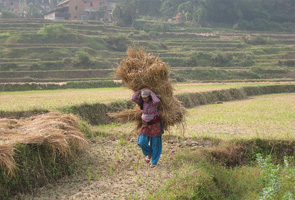Department of Agricultural Economics
Comprehensive science linking agricultural science and economic society, from production to consumption

The world population was 7 billion in the beginning of 2012, and it is expected to be 8 billion in 2025. What would the food or natural environment be then in relation to humans? Unbalanced growth of the world economy has led to an asymmetrical global pattern of gorging and starving. In addition, biological species are getting extinct and resources such as soil and water are becoming scarce, while the production of food has increased. Presently, Japan depends on imported food although it has rich farmland. How can we solve such serious issues?
The need of the hour is to rejuvenate the coexistence of humans and nature while re-evaluating diverse forms of agriculture. In addition, finding solutions to these problems and creating a new framework is required. This is the present role and goal of agricultural economics. You can participate in our various seminar activities to broaden your knowledge sphere and acquire a scientific perspective of the world.
Check!
- Department of Agricultural Economics has the following 7 research groups.
- The department’s biggest feature is “integration of humanities and science,” which applies the principles of humanities to agricultural science.
- Our research field reaffirms the conditions in Hokkaido, Japan and worldwide through agricultural economics, for instance, Hokkaido’s original large-scale farming and Japanese inherent cooperative.
- The root of the department can be traced back to Professor Inazo Nitobe, who became the “face” of the former 5000-yen bill. “Tradition and foresight” over one century has been uninterruptedly inherited until now.
- The department has its own quality library with professional librarians. It was named at the time of its establishment as “Westcott and Lewis Library” after the book donors.
Study in Department
-
Agricultural and Environmental Policy
Current research activities: comparative studies on agricultural policies in foreign countries; analysis on economic effects of agricultural policies; agricultural environmental policies and multifunctionarity in agriculture.
-
Farm Business Management
Current research activities: local support system for the development of farm business; intergenerational farm transfer; effects of direct payment policy on farm business.
-
Agricultural and Rural Development
Current research activities: Theoretical and positive analysis of agricultural technology transfer from developed countries to developing countries with a special focus on Nepal and other less developed countries; economic analysis of the diffusion of newly developed agricultural technology in Japan; agricultural planning and regional development, evaluation of public investment projects in agricultural sector.
-
Agricultural Cooperatives
Current research activities: wide aspects of agricultural cooperative and other farmers’ organization around the world, including basic theory of systems and functions.
-
Food and Agricultural Marketing
Current research activities: theory and history of agricultural market structure; theory and policy of price for farm products; analysis of the market for the farm products and the agricultural inputs.
-
Socio-Economics of Rural Network and Development
Current research activities: Cooperative and collaborative network for rural development, rural development projects and food quality policies.
-
Agricultural Resource Economics
Current research activities: Evaluate the Contribution of Genetic Diversity in Agricultural Production, Producer/Consumer Acceptance to the New Crop Variety, Institutional Framework over the Agricultural Genetic Resources.
